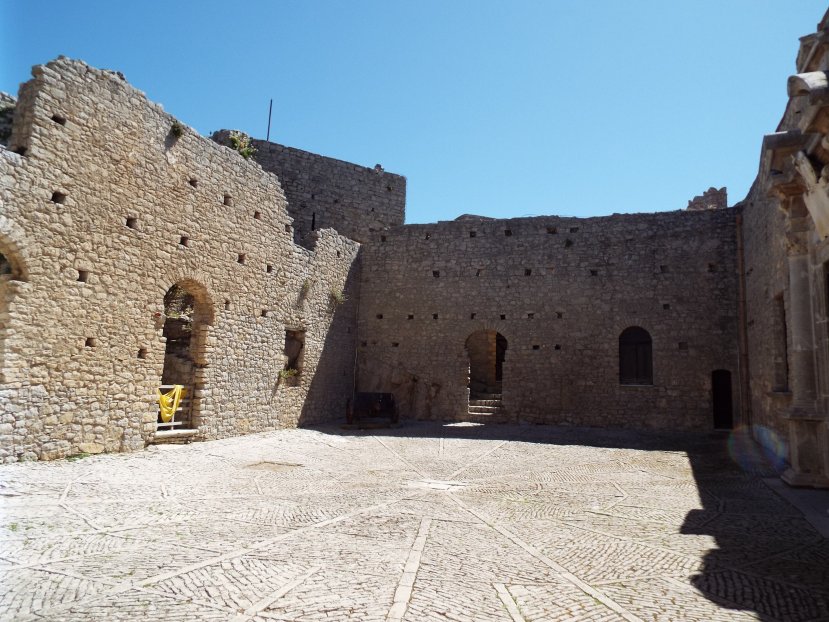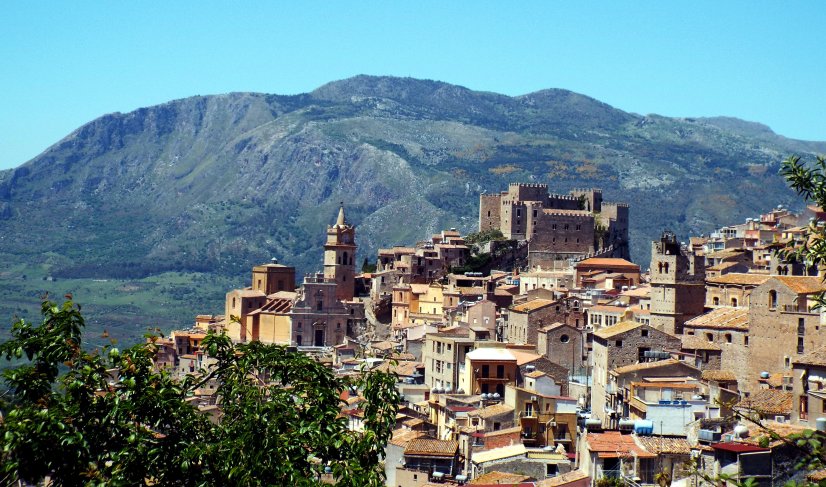Caccamo
In 1651 Agostino Inveges (d.1677) attributed the origins of the
castle to the Carthaginians following the battle of nearby Imera Gelone
in 480 BC. More likely the place is first noticed in 800 AD when
Cucumo was mentioned in a Byzantine record. More certain is the
record of 1094 when Count Roger gave Caccamo to the Normans, Geoffrey
and Adelasia Sageyo. From their heiress the castle passed to her
husband, William Bonellus, who was holding the castle in 1137 with his
wife, Sybilla and their son, Tancred. This son obviously died, as
had his parents by November 1157, when Matthew Bonellus confirmed his
father's foundation of St Angelo priory near their other holding of
Prizzi, also in the mountains above Palermo. Such confirmations are usually undertaken when a lord assumes his new patrimony.
Although young, Matthew was apparently popular with the barons and
people and he used this popularity to raise 3 rebellions against King William I (d.1166). Firstly he murdered Admiral Maio in November 1160 and then fled the 22 miles from Palermo
to Caccamo castle. After being forgiven by the king, who had
since been convinced of Maio's treachery, he was summoned back from
Caccamo with oaths that the king was happy in Maio's death and to the
alleged adoration of the crowds and nobility. Despite this, the queen and palace eunuchs, held Matthew guilty of the
murder of the Admiral and plotted to turn the king's mind against him.
Consequently the king asked for the payment of the 60,000 tari debt
that Matthew owed as his inheritance tax on the death of his father and
which had been deferred by Maio.
This probably led to the second revolt which went off prematurely while Matthew was at Mistretta castle in March 1161 and resulted in the death of the king's son in Palermo palace. Matthew advanced with his army from Mistretta to Caccamo and found his fellow conspirators hiding there from the wrath
of King William. Matthew then wrote to the king stating that he
was disturbed to hear of the king's capture and was marching with his
army to release him when he received news at Caccamo that the king was
already freed. The king replied to Matthew asking why he was now
sheltering these same rebels in his castle? He replied
that although he was unconnected with the uprising, the men were his
friends and colleagues and so he could not refuse them shelter.
He also stated that he agreed with their reason for rebellion, that the
king refused them the right to marry off their daughters until they
were too old to be child bearing. He did not state the obvious
conclusion of this, that the estates of the ladies would then escheat
to the Crown as they bore no children to succeed them. The king
was infuriated by this reply as the matter had not earlier been raised
before him when he would have done justice as the law required.
In a final desperate bid to overthrow the king, Matthew again attacked
Palermo, but he was too late, as the king's
reinforcements had arrived from
Messina by sea and other forces reached him from the interior.
Consequently Bonellus retreated, this time to King Roger's palace at Favara. Further
negotiations then led to the exile of the main plotters, taken out of
the realm in the king's galleys, but Matthew
was welcomed back into royal favour. The exiled plotters seem to
have fled either to the mainland of Italy, to Jerusalem or to Byzantium where Count Simon, the king's half-brother and
Alexander Conversano were found in 1166 and 1168.
Towards the end of April there was further unrest in central Sicily which resulted in the destruction of Piazza Armerina and Butera
when Tancred of Lecce and Roger Sclavo, the illegitimate son of Simon
Vasto of Butera, had seized them from their Lombard garrisons. On
hearing of this the king simply arrested Matthew and, after his prison
was attacked and Atenulf the royal chamberlain cut down by one of
Matthew's knights, the king had Matthew blinded and hamstrung, after
which he was left to die in a dungeon according to 'Falcandus'.
However, other evidence suggests he survived until at least November
1173 when he had been released and restored to favour by King William II (d.1189). In this uncertain manner ended the best documented lord of Caccamo.
As
a result of Bonellus' alleged death in 1161, Caccamo was held by the
Crown until 1168 when Chancellor Stephen Perche (d.1169) granted
Bonellus' lands to John Lavardin
(d.1185). He was one of the many French lords called to court by
the widowed Queen Margaret of Navarre (d.1172+), regent from 1166 of
her underage son William II
(1166-89). John immediately tried to tax all his tenants on his
accession to the lordships of Caccamo and Prizzi, causing further
hatred against all the French in Sicily. Eventually his subjects
rebelled, besieged him in his own fortress and forced his
surrender. Caccamo was then declared a state-owned city by the Messina parliament
and given the title of Urbs generosissima - the most noble city.
During the minority of Frederick II (1198-1208), in 1203 the church of St Maria la Mensa was supposedly demolished to
extend the castle before it was given to the Genoese nobleman, Paolo
Cigala, who was also made constable of Sicily. As he died without
heirs, the Emperor Frederick II (1198-1250) granted Caccamo to the archbishop
of Palermo, Bernardo del Castagno, in 1215. The archbishops held
it until 1267, when it was given to Fulcone Podio. The castle
then passed to his son-in-law, Galasso Estendardo, a French knight, who
was exiled during the Sicilian Vespers of 1282. At the beginning
of this uprising a troop of archers from Caccamo helped besiege Vicari
castle and killed John St Remy, the French justiciar of
Sicily.
After the Sicilian uprising of 1282, the castle is said to have been occupied
by Frederick
Chiaramonte. He was an Angevin who had arrived with Charles I
(1268-85), but threw in his lot with the rebels in 1282. It is
claimed he extended Caccamo castle before his death, allegedly in
1286. Traditionally he is supposed to have inherited the castle
through his heiress wife, Marchisia (Markisia) Prefoglio. However,
the fee actually seems to have only been granted to his son
Manfred (d.1321) in 1296 for his support of the usurpation of Frederick III (d.1337). Manfred is claimed to have built 2 more towers and restored
the south and east buildings in the early 1300s. He was also lord of nearby Vicari castle as well as Favara near Agrimento. Before 1300 he was also made count of Modica.
In 1302 the castle repelled a surprise assault by an Angevin army
trying to break through to the interior of the island in the war which
ended at Caltabellotta that year.
In 1392 the last Chiaramonte, Andrew, was beheaded in Palermo before
the Steri palace for opposing King Martin I (d.1409). Caccamo
castle was then entrusted to the Catalan Gerald Queralto, but the
people resented this and drove him out, King Martin granting the town
autonomy on 19 March 1396. Despite this, the county of Caccamo
was given to Don Giaimo or Giacomo Prades. Faced with the open
hostility of the Caccamese, Giacomo updated the fortifications, dying a
natural death in 1420. The castle entrance was given a new gate
and equipped with a drawbridge in 1526. Various works continued
until 1665 and finally an earthquake ruined the castle in 1823.
It has since been heavily restored.
Description
Caccamo castle stands on a rocky spur on the northeast side of Mount
Calogero. The building is made of limestone quarried from its
immediate environs. The castle consists of at least 3 constituent
parts. The heart of the castle is a rectangular keep set on a
rock motte and dominating the surrounding area. This thick walled
tower, with narrow lancet windows, collapsed in the earthquake of
1823. To the west is a ground floor entrance. The keep may have borne similarities to the keeps at Aci and Milazzo.
 South of the keep
was the inner bailey which is now marked by a rectangular courtyard and
a row of buildings running along the top of the ridge. Centrally
is a large projecting square tower. To the west, north and east there is an
outer ward with a rectangular gatetower to the northeast, leading to the town.
South of the keep
was the inner bailey which is now marked by a rectangular courtyard and
a row of buildings running along the top of the ridge. Centrally
is a large projecting square tower. To the west, north and east there is an
outer ward with a rectangular gatetower to the northeast, leading to the town.
The castle is accessed by going through an entrance gate that leads
into a courtyard overlooked by fifteenth century buildings.
Through a second gate is a quiet courtyard. A round arch, above
which is a pointed arch, leads to a terrace, in which stands the small
court church and the entrance to the prisons. Within is the
hall ‘of the conspiracy' because, according to tradition, it was
in this hall that in 1160 the barons plotted their rebellion against
King William.
The north part of the castle was remodelled for the Chiaramonte.
This consists of the northeast wing, a tower close to the keep and the tower
called del Pizzarrone placed at the mouth of the downstream
sewers. The Gibellina tower was also restored about this time.
Why not join me here and at other Sicilian
castles? Information on this and other tours can be found at Scholarly
Sojourns.
Copyright©2019
Paul Martin Remfry


 South of the keep
was the inner bailey which is now marked by a rectangular courtyard and
a row of buildings running along the top of the ridge. Centrally
is a large projecting square tower. To the west, north and east there is an
outer ward with a rectangular gatetower to the northeast, leading to the town.
South of the keep
was the inner bailey which is now marked by a rectangular courtyard and
a row of buildings running along the top of the ridge. Centrally
is a large projecting square tower. To the west, north and east there is an
outer ward with a rectangular gatetower to the northeast, leading to the town.